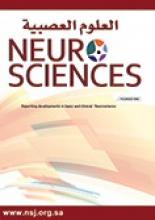Abstract
OBJECTIVE: To determine the prevalent bacterial agents of neonatal meningitis and their antibiotic susceptibility in a referral intensive care unit in Assir Central Hospital, Saudi Arabia, during the years 1993-1998.
METHODS: Records of newborn infants with positive cerebrospinal fluid culture during the period were retrospectively studied.
RESULTS: There were 1473 nursery admissions, of which 32 episodes of meningitis occurred amongst 31 neonates. Klebsiella pneumoniae (31%) and Serratia marcescens (21%) were the main pathogens. The incidence of concurrent septicemia among these infants was 58%. Klebsiella pneumoniae appears to dominate in both early and late onset infections. The sex incidence was equal and the mortality rate was 48%.
CONCLUSION: The survey identifies Klebsiella pneumoniae and Serratia sp. as the leading bacterial agents of neonatal meningitis in our environment. The relatively high frequency of Serratia infection in the present survey appears unique as this organism is comparatively rare in other reports across the globe. No Group B Streptococcus was isolated, which is in contrast to reports obtained in Europe, America and Australia where it is the predominant organism of neonatal sepsis or meningitis. Antibiogram identified imipenem and cefotaxime as the empirical antibiotics in infants with a clinical diagnosis of neonatal sepsis in our hospital; no more conventional use of ampicillin. In view of the changing bacterial pattern of infant infection with time even in the same environment, a periodic review of this subject is advocated.
- Copyright: © Neurosciences
Neurosciences is an Open Access journal and articles published are distributed under the terms of the Creative Commons Attribution-NonCommercial License (CC BY-NC). Readers may copy, distribute, and display the work for non-commercial purposes with the proper citation of the original work.






